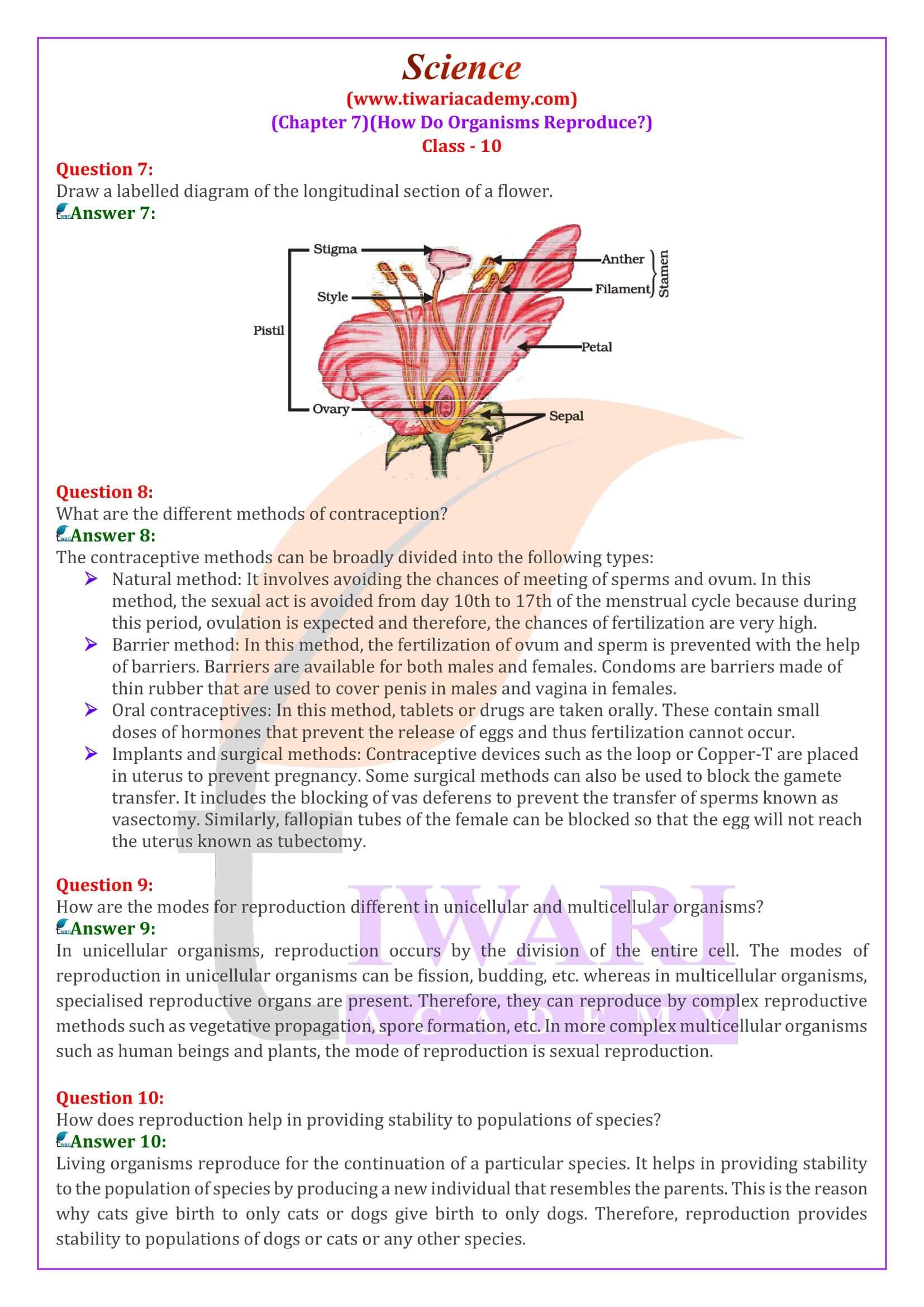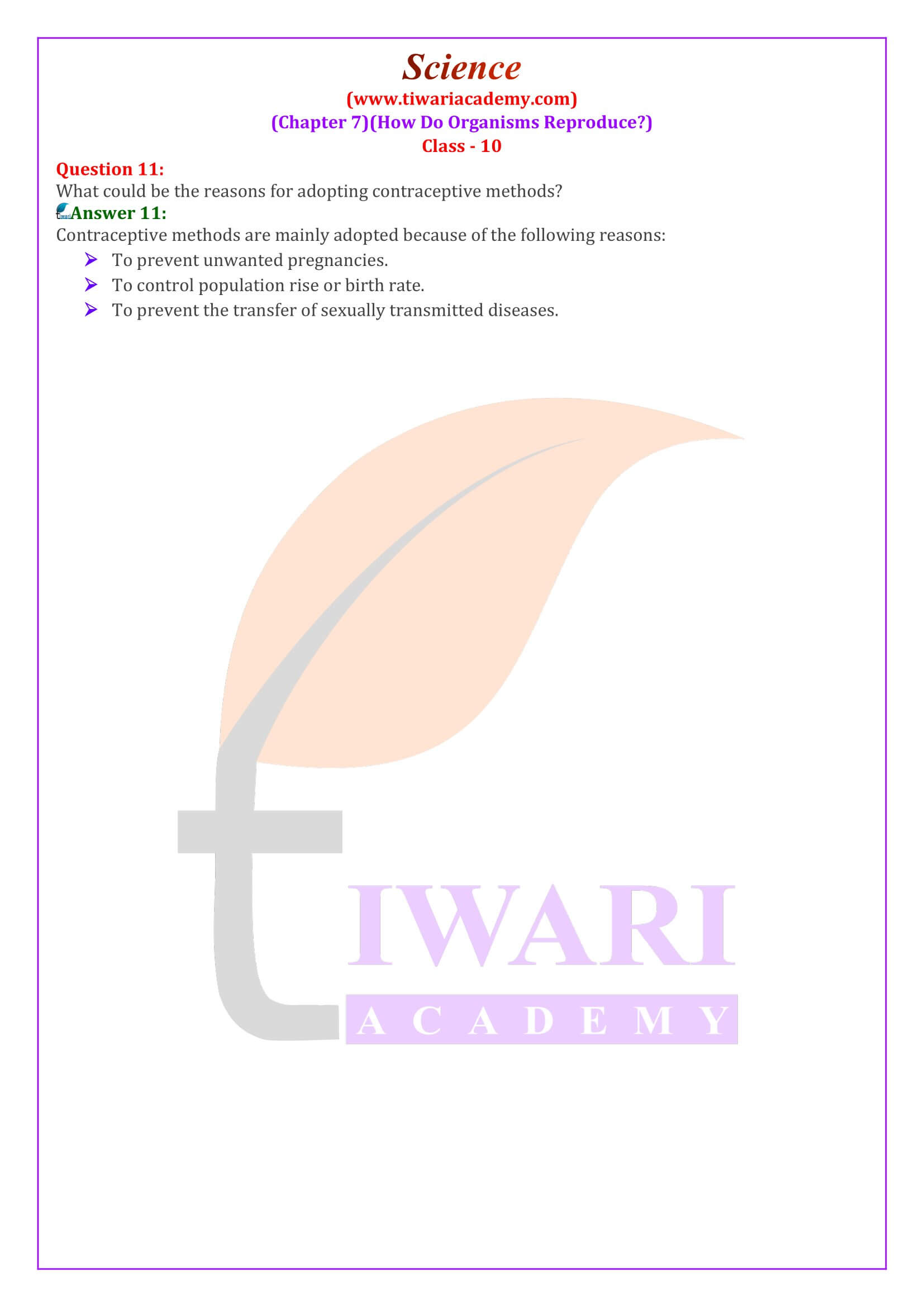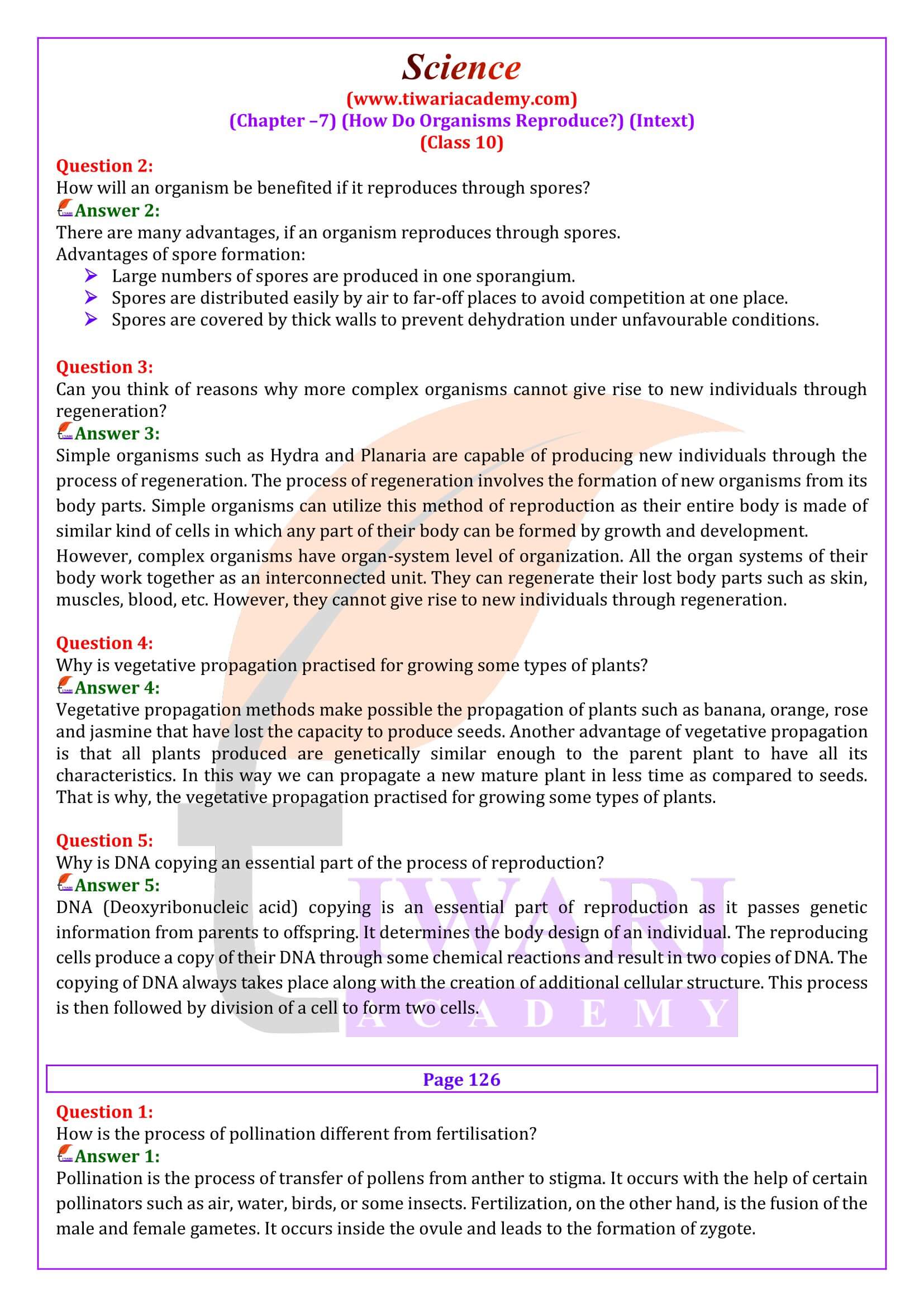NCERT Solutions for Class 10 Science Chapter 7 How do Organisms Reproduce? in Hindi and English Medium updated for CBSE 2025-26. Get the revise solutions of class 10th science chapter 7 based on latest textbooks and syllabus for academic year 2025-26.
Preparation for Class 10 Science
Class 10 Science Chapter 7 Solutions
Class 10 Science Chapter 7 Exercises Solutions
Class 10 Science Chapter 7 Intext Exercises
Class 10 Science Chapter 7 in Hindi Medium
Class 10 Science Book Download in PDF
Class 10 Science Chapter 7 Board Questions
Class 10 Science Chapter 7 MCQ
Class 10 Science Chapter 7 Extra Questions
Class 10 Science NCERT Solutions
Class 10 all Subjects Solutions
In NCERT Class 10 Science, Chapter 7 is how do Organisms Reproduce? This chapter explains in detail about reproduction in organisms. Here are the main topics covered in this chapter introduction to Reproduction.
Class 10 Science Chapter 7 Questions in Detail
- What is the importance of DNA copying in reproduction?
- Why is variation beneficial to the species but not necessarily for the individual?
- How does binary fission differ from multiple fission?
- How will an organism be benefited if it reproduces through spores?
- Can you think of reasons why more complex organisms cannot give rise to new individuals through regeneration?
- Why is vegetative propagation practised for growing some types of plants?
- Why is DNA copying an essential part of the process of reproduction?
- How is the process of pollination different from fertilisation?
- What is the role of the seminal vesicles and the prostate gland?
- What are the changes seen in girls at the time of puberty?
- How does the embryo get nourishment inside the mother’s body?
- If a woman is using a copper-T, will it help in protecting her from sexually transmitted diseases?
- What are the advantages of sexual reproduction over asexual reproduction?
- What are the functions performed by the testis in human beings?
- Why does menstruation occur?
- Draw a labelled diagram of the longitudinal section of a flower.
- What are the different methods of contraception?
- How are the modes for reproduction different in unicellular and multicellular organisms?
- How does reproduction help in providing stability to populations of species?
- What could be the reasons for adopting contraceptive methods?
| Class: 10 | Science |
| Chapter 7: | How do Organisms Reproduce? |
| Content: | Exercise and Extra Question Answers |
| Content Type: | Text, PDF and Videos Format |
| Session: | CBSE 2025-26 |
| Medium: | English and Hindi Medium |
An overview of the concept of reproduction in living organisms. The significance of reproduction for the continuation of species, detailed explanation of asexual reproduction, various methods of asexual reproduction, including fission, budding, fragmentation, and spore formation are examples of organisms that reproduce asexually.
Class 10 Science Chapter 7 Answers in Hindi and English Medium
- Class 10 Science Chapter 7 Exercises
- Class 10 Science Chapter 7 Intext Questions
- Class 10 Science Chapter 7 in Hindi
- Class 10 Science Chapter 7 in PDF
- Class 10 Science Chapter 7 Board Questions
- Class 10 Science Chapter 7 MCQ
- Class 10 Science Chapter 7 Extra Questions
- Class 10 Science NCERT Solutions
- Class 10 all Subjects Solutions
A brief introduction of chapter 7 in 10th Science
Basic Concepts of Reproduction: Class 10 Science chapter 7 begins by discussing the fundamental aspects of reproduction, emphasizing the role of DNA in inheritance and the importance of creating DNA copies for reproduction. It explains how changes in DNA can lead to different proteins and ultimately result in varied body designs.
Reproductive Methods in Various Organisms: Class 10 Science chapter 7 covers different reproductive strategies in organisms, including asexual methods like fission in single-celled organisms (e.g., Plasmodium) and fragmentation in multicellular organisms like Spirogyra. The chapter also discusses sexual reproduction in humans, detailing the changes that occur during puberty and the functioning of male and female reproductive systems.
Human Reproductive System: The 10th Science chapter 7 provides detailed descriptions of the male and female reproductive systems, explaining the process of egg and sperm production, fertilization, and embryo development. It also discusses menstrual cycles and reproductive health.
Pregnancy and Embryo Development: The process of embryo implantation in the uterus, the role of the placenta in nourishment, and the overall development of the embryo are explained. Class 10 Science chapter 7 also touches on the physical and hormonal changes that occur during pregnancy.
Reproductive Health and Social Aspects: Class 10 Science chapter 7 addresses the importance of reproductive health and the societal pressures related to sexual activity, marriage, and childbearing. The chapter 7 of 10th science encourages thoughtful consideration of these pressures and the importance of making informed choices.
Exercises and Questions: The chapter 7 of 10th science concludes with a series of exercises and questions designed to test understanding of the concepts covered, including the differences between various reproductive processes, the structure of reproductive systems, and the significance of reproductive health.
Class 10 Science chapter 7 explains about the detailed explanation of sexual reproduction, the role of male and female reproductive organs in sexual reproduction. It also describes fertilization and the formation of zygotes, structure and functions of the male and female reproductive systems. Students can learn here about the process of gametogenesis (formation of sperm and egg cells) in males and females and menstrual cycle and ovulation in females.
The main topics to learn for exams are development of the zygote into an embryo, pregnancy and the stages of embryonic development, the importance of reproductive health and hygiene, common reproductive health issues and their prevention, family planning methods and their significance.
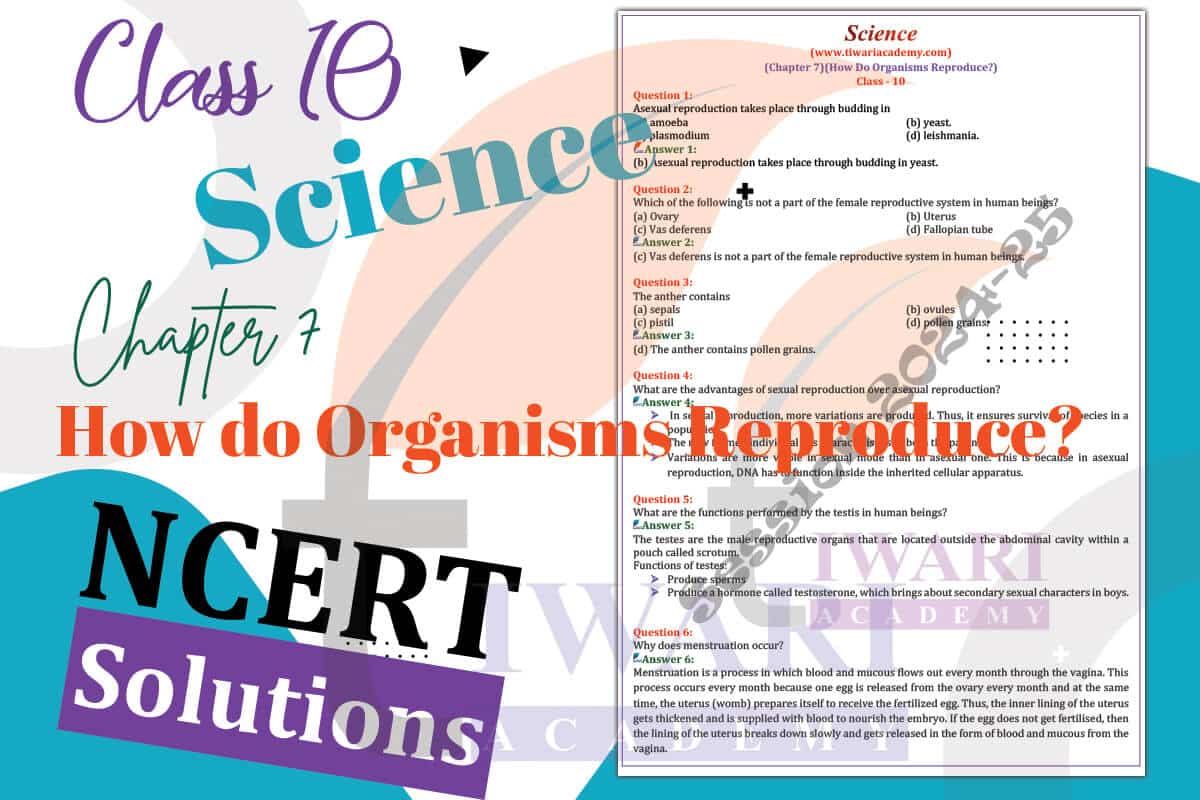
We will learn here that the role of genes and DNA in inheritance. The occurrence of variation in offspring. Explanation of how sex is determined in different organisms. Human sex determination and the role of sex chromosomes. Structure and functions of the male and female reproductive organs in flowering plants (stamen and pistil). The process of pollination and fertilization in plants. Formation of seeds and fruits.
Class 10 Science chapter 7 helps to know the different reproductive strategies adopted by animals, examples of oviparous and viviparous animals, advantages and disadvantages of various reproductive strategies. This chapter provides a comprehensive understanding of the various ways in which organisms reproduce, from simple asexual methods to complex sexual reproduction. It also introduces students to the human reproductive system and the basics of genetics and heredity. Understanding these concepts is essential for a strong foundation in biology.
NCERT Solutions for Class 10 Science Chapter 7
Extra important questions related to Chapter 7 of 10th Science are also given with previous years CBSE Board questions and answers. CBSE Solutions Apps based on latest NCERT Books download for offline use.
Class X Science NCERT textbook chapter 7 intext question answers of Page 128 or Page 133 or Page 140 or Exercises in English Medium updated for new academic session. All the contents in dual Medium on this website are free to use without any login or password.
Hindi Medium NCERT Solutions of 10th Science chapter 7 Hindi Medium Solution are given to view online or free download in PDF format. UP Board Students are also using NCERT Books in the session 2025-26, so download UP Board Solutions for Class 10 Science Chapter 7 from here in Hindi or English Medium.
Preparing for NCERT Class 10 Science Chapter 7, how do Organisms Reproduce, here’s a step-by-step plan to help students prepare this chapter effectively. Begin by reading the entire chapter carefully to get an overview of the topics covered. Pay special attention to the definitions, terms, and processes related to reproduction, both asexual and sexual. While reading, take notes that summarize each section. Include important definitions, processes, and examples. These notes will be useful for quick revision.
To prepare the chapter 7 of 10th Science, create diagrams and flowcharts to visualize the processes of reproduction, especially those involving human reproductive systems and flower structures. Diagrams can help in understanding and retention. Understand the differences between asexual and sexual reproduction.
Be able to identify examples of organisms that reproduce using each method. Pay close attention to the structure and functions of the male and female reproductive systems in humans. Understand the processes of gametogenesis, fertilization, and embryo development.
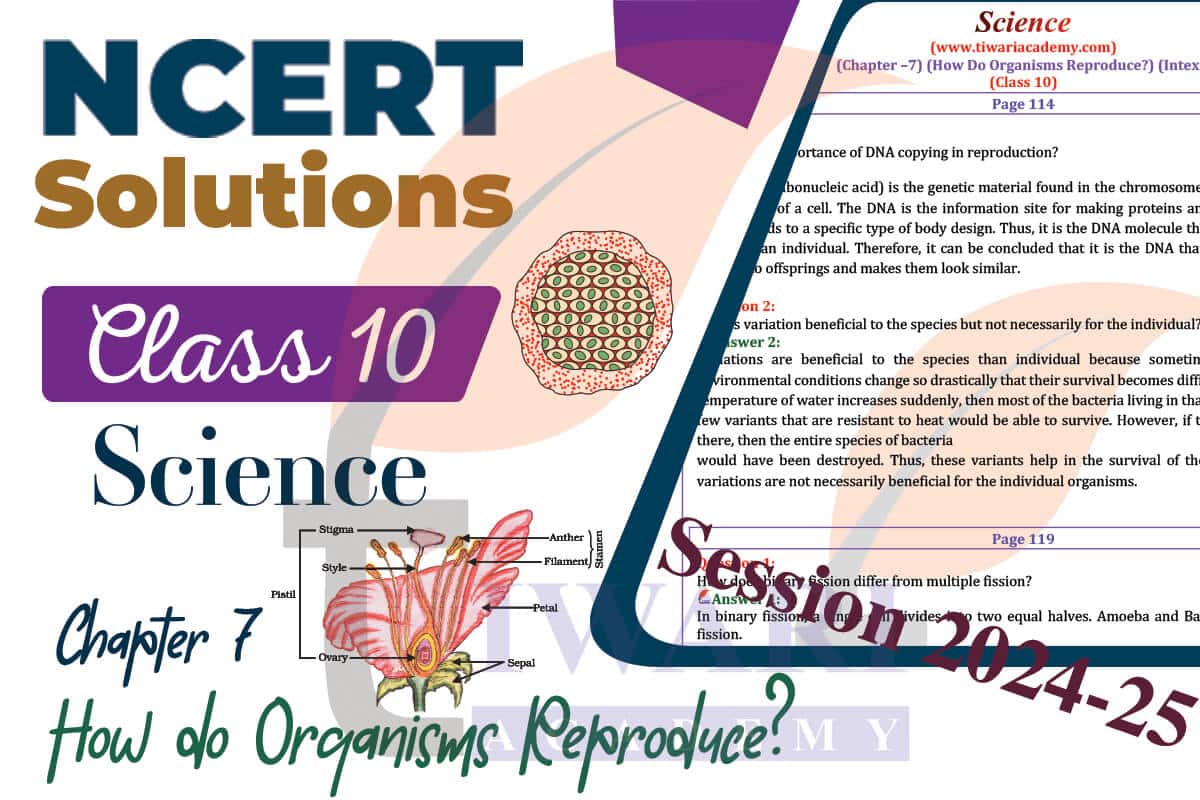
Learn about Reproductive Health- Study the importance of reproductive health and hygiene. Be aware of common reproductive health issues and family planning methods. Understand the basics of genetics, genes, DNA, and inheritance. Comprehend how variation occurs in offspring. Solve the questions provided at the end of the chapter. This includes both multiple-choice and descriptive questions. Pay attention to numerical problems and their solutions.
If you find certain concepts, in chapter 7 of 10th Science, challenging, refer to supplementary resources such as online tutorials, videos, or reference books to gain a deeper understanding. Periodically review your notes and practice questions to reinforce your memory of the chapter’s content. Practice labeling diagrams related to flower structures, human reproductive organs, and other key concepts. This can help you score well in exams.
10th Science Chapter 7 Answers in English & Hindi Medium
NCERT Solutions for Class 10 Science Chapter 7 How do Organisms Reproduce? Intext question as well as chapter end exercises question answers are given below updated for new academic year. Ask your doubts through Discussion Forum and answer the questions asked by the other users.
Engage in discussions with classmates or study groups to clarify doubts and reinforce your understanding of the material. Allocate specific time slots for studying this chapter in your overall study schedule. Consistency in studying is crucial. Solve previous years’ question papers to become familiar with the types of questions that may appear in the board exams.
Remember that understanding the concepts and processes related to reproduction is crucial for both your board exams and for building a strong foundation in biology. Take a systematic approach, and don’t rush through the material.
Class 10 Science Chapter 7 Extra Question Answers
What is the importance of DNA copying in reproduction?
DNA found in chromosomes in the nucleus of the cell has the information to create proteins which lead to body design of an organisms. If the organisms are to make exact copies of themselves, the DNA should replicate to make an exact copy of itself. DNA replicate in the cell with the help of various enzymes and this is accompanied by division of the basic unit of every organism, i.e., the cell.
What are sexually transmitted diseases? Name an STD which damages the immune system of human body.
The sexually act is very intimate connection of bodies and thus many diseases can be sexually transmitted. These include bacterial infections like gonorrhoea and syphilis and viral infection like warts and HIV-AIDS (Human Immunodeficiency Virus-Acquired Immuno Deficiency Syndrome). HIV-AIDS causes damages to the immune system of human body.
Why is variation beneficial to the species but not necessarily for the individual?
Variations are useful for the survival of species in changed environmental situations. For example, if a population of reproducing organisms were suited to a particular niche (well defined place of abode) and if the niche is drastically changed, the population could be wiped out. However, if some variations were to be present in a few individuals in these populations, there would be some chance for them to survive. Thus, if there is a population of bacteria living in temperate waters and if water temperature increases by global warming, most of bacteria would die. But few a variants resistant to heat would survive and grow further. Variation is thus useful for the survival of species over time.
What are the three categories of contraception methods? Write briefly about each.
The methods used for regulation of child birth are:
(i) Barrier method: In this method physical devices like condoms, cervical cap and diaphragm are used to prevent sperms to reach up to the ovum.
(ii) Chemical method: In this method specific drugs are used by females. These drugs may be (a) oral pills or (b) vaginal pills. Oral pills mainly contains hormones and are called oral contraceptives. They disturb hormonal balance so that eggs are not released and fertilised.
(iii) Intrauterine contraceptive devices (IUCDs): ICUD like copper-T is placed safely in the uterus by skill doctor. ICUDs prevents implantation of the fertilized ovum inside the uterus.
(iv) Surgical method: this method is applicable to both male and female. In males, a small portion of vas deferens and the fallopian tube in female is surgically removed or ligated (tied). It is known as vasectomy in males which prevents release of sperms from the testes. In females, it is called tubectomy.
“Multicellular organisms cannot divide cell by cell.” List two reasons to justify this statement.
Multi cellular organisms cannot simply divide cell by cell because:
(i) Many multi cellular organism are not simply a random collection of cells. Specialised cell are organised as tissues and tissues are organised into organs which are placed at a definite position in the body.
(ii) Each organ performs a specific function/functions.
In such a carefully organised situation, cell by cell division (for reproduction) would be impracticable.
Describe menstrual cycle.
The uterus develops thick and spongy lining to receive fertilised egg. When the egg is not fertilised, uterine lining slowly break and comes out as blood and mucous. This cycle takes place roughly every month and is known as menstrual cycle (menstruation).
Define the process of fragmentation in some organisms. Which category of organisms are involved in this process? Give one example.
Fragmentation: The mode of reproduction of simple multicellular organisms in which body simply breaks up into smaller pieces upon maturity and each piece or fragment grows into a new individual is called fragmentation. The relatively simple multicellular organisms which are simply a random collection of cells are involved in fragmentation type of reproduction. Example: Spirogyra.
What is the role of seminal vesicle and the prostate gland?
Role of seminal vesicle and Prostate gland.
Along the path of the vas deferens, these glands add their secretions so that the sperms are now in a fluid which makes their transport easier and this fluid also provides nutrition to sperms.
What is pollination? List the modes of pollination and define each of them?
The transfer of pollen grains form anther of stamen to stigma is called pollination. The transfer of pollen from the anther of one flower to the stigma of another flower of a different plant of the same species is called cross pollination. In this case, pollen grains of the same flower do not pollinate its stigma. In cross pollination, the transfer of pollen grains may take place through some agency like wind, insect, bird, water, mammals etc.
Transfer of pollen from the anther of a flower to the stigma of the same flower or a flower on the same plant is called self pollination.
Tiwari Academy provides a variety of practice questions and exercises related to 10th Science Chapter 7. These questions can help students test their understanding of the material and improve their problem-solving skills.
To help students prepare for exams, the platform offer sample papers and previous years’ question papers. Solving these papers can help students familiarize themselves with the exam pattern and practice answering questions effectively.
10th Science Chapter 7 Questions for Practice
Question 1:
(a) Name the following:
(i) Thread like non-reproductive structures present in Rhizopus.
(ii) ‘Blob’ that develops at tips of the non-reproductive threads in Rhizopus.
(b)Explain the structure and function of the structures released from the ‘blobs’ in Rhizopus.
Answer 1:
(a) (i) Hyphae
(ii) Sporangia
(b) On maturity sporangia ruptures and release spores. Each spore contains a nucleus and cytoplasm enclosed in a thick wall for protection.
Function: Spores disperse far and wide. Each spore grows into new Rhizopus when come in contact of moist surface and other suitable conditions.
Question 2:
Differentiate between pollen gains and ovule?
Answer 2:
Pollen grain produces male germs-cell (male gamete) in the plants. The ovule contains a female gamete (female germ cell or egg).
Questions from Board Papers
Question 1:
Name the plant that reproduces through leaves. List two advantages of this way of reproduction.
Answer 1:
Bryophyllum
Advantages:
(i) Many buds are produced in the notches along the margin of a single leaf. Each leaf-bud of Bryophyllum produces a plant.
(ii) The plants from the buds are exactly similar to the parent plant.
(iii) A large number of young plants are produced by a single leaf of a plant that helps in survival of the species.
Important Questions on 10th Science Chapter 7
What is the importance of DNA copying in reproduction?
DNA found in chromosomes in the nucleus of the cell has the information to create proteins which lead to body design of an organisms. If the organisms are to make exact copies of themselves, the DNA should replicate to make an exact copy of itself. DNA replicate in the cell with the help of various enzymes and this is accompanied by division of the basic unit of every organism, i.e., the cell.
Why is variation beneficial to the species but not necessarily for the individual?
Variations are useful for the survival of species in changed environmental situations. For example, if a population of reproducing organisms were suited to a particular niche (well defined place of abode) and if the niche is drastically changed, the population could be wiped out. However, if some variations were to be present in a few individuals in these populations, there would be some chance for them to survive. Thus, if there is a population of bacteria living in temperate waters and if water temperature increases by global warming, most of bacteria would die. But few a variants resistant to heat would survive and grow further. Variation is thus useful for the survival of species over time.
Name the plant that reproduces through leaves. List two advantages of this way of reproduction.
Bryophyllum Advantages: (i) Many buds are produced in the notches along the margin of a single leaf. Each leaf-bud of Bryophyllum produces a plant. (ii) The plants from the buds are exactly similar to the parent plant. (iii) A large number of young plants are produced by a single leaf of a plant that helps in survival of the species.
How does the process of budding is differ from the process of spore formation?
Budding: A bud, as in Hydra, develops as an outgrowth due to replicated cell division at a specific site. These buds when mature detach from the parent body and become new individual. Spore Formation: In spore formation, as in Rhizopus, a specific part called Sporangia that produce spores. The spores are covered by thick walls that protect them until a spore gets favourable conditions to grow into a new (Rhizopus) plant.
What are the advantages of sexual reproduction over asexual reproduction?
Advantages of sexual reproduction: In sexual reproduction, more variations are produced. Thus, it ensures survival of species in a population. The new formed individual has characteristics of both the parents. Variations are more viable in sexual mode than in asexual one. This is because in asexual reproduction, DNA has to function inside the inherited cellular apparatus.
What are the functions performed by the testis in human beings?
The testes are the male reproductive organs that are located outside the abdominal cavity within a pouch called scrotum. Functions of testes: Produce sperms Produce a hormone called testosterone, which brings about secondary sexual characters in boys.
Why does menstruation occur?
Menstruation is a process in which blood and mucous flows out every month through the vagina. This process occurs every month because one egg is released from the ovary every month and at the same time, the uterus (womb) prepares itself to receive the fertilized egg. Thus, the inner lining of the uterus gets thickened and is supplied with blood to nourish the embryo. If the egg does not get fertilised, then the lining of the uterus breaks down slowly and gets released in the form of blood and mucous from the vagina.
What are the different methods of contraception?
The contraceptive methods can be broadly divided into the following types: Natural method: It involves avoiding the chances of meeting of sperms and ovum. In this method, the sexual act is avoided from day 10th to 17th of the menstrual cycle because during this period, ovulation is expected and therefore, the chances of fertilization are very high. Barrier method: In this method, the fertilization of ovum and sperm is prevented with the help of barriers. Barriers are available for both males and females. Condoms are barriers made of thin rubber that are used to cover penis in males and vagina in females. Oral contraceptives: In this method, tablets or drugs are taken orally. These contain small doses of hormones that prevent the release of eggs and thus fertilization cannot occur. Implants and surgical methods: Contraceptive devices such as the loop or Copper-T are placed in uterus to prevent pregnancy. Some surgical methods can also be used to block the gamete transfer. It includes the blocking of vas deferens to prevent the transfer of sperms known as vasectomy. Similarly, fallopian tubes of the female can be blocked so that the egg will not reach the uterus known as tubectomy.
What could be the reasons for adopting contraceptive methods?
Contraceptive methods are mainly adopted because of the following reasons: (i) To prevent unwanted pregnancies. (ii) To control population rise or birth rate. (iii) To prevent the transfer of sexually transmitted diseases.
Question 2:
Give functions of the following organs of the human male reproductive system.
(a) Scrotum
(b) Testes
Answer 2:
(a) Testes are placed in scrotum which are located outside the abdominal cavity. It keeps the temperature lower than the normal body temperature that is required for the formation of sperm.
(b) Testes produce sperm and male hormone testosterone.
Tiwari Academy’s Discussion platforms have doubt-clearing sessions where students can ask questions related to the chapter, and educators or experts will provide explanations and clarifications. Interactive quizzes and tests can help students assess their knowledge and track their progress. These quizzes designed to simulate the format of actual exams. Class 10 Science chapter 7 involve complex diagrams and illustrations related to reproductive processes in plants and animals.
The chapter 7 of 10th Science includes diagrams related to flower structures, human reproductive organs, and other concepts. Students may be asked to label these diagrams or explain specific parts and their functions, making diagram-based questions important. Examination questions present scenarios or case studies related to reproduction in organisms. Students may need to apply their knowledge to analyze these situations and explain the outcomes.
Understanding the human reproductive system, including the structure and functions of male and female reproductive organs, processes like gametogenesis, fertilization, and embryonic development, is crucial. Questions related to human reproduction are common in exams. Reproductive health is a significant component of this chapter. Questions may focus on the importance of reproductive health, common reproductive health issues, and family planning methods.
The 10th Science chapter 7 briefly introduces students to the concepts of genetics and heredity, which are fundamental in biology. Questions may assess a student’s understanding of how genes, DNA, and variation play a role in reproduction. Some questions require practical knowledge, such as understanding the steps involved in the menstrual cycle in females or the process of fertilization. Mastery of Chapter 7 serves as a foundation for understanding more advanced concepts related to reproduction, genetics, and evolution in higher classes. It is essential for students who plan to pursue biology in their future studies.
In summary, NCERT Class 10 Science Chapter 7 is vital for both board examinations and future studies in biology. It covers fundamental biological concepts and practical knowledge related to reproduction in organisms, making it an important topic for students to prepare thoroughly.
How is Tiwari Academy helpful in preparation for NCERT Class 10 Science Chapter 7?
Tiwari Academy is an online education platform that offers resources and assistance to students preparing for various exams, including NCERT Class 10 Science. Tiwari Academy’s offerings for NCERT Class 10 Science Chapter 7, how do Organisms reproduce? It provides comprehensive chapter notes that summarize key concepts, definitions, and important points from Chapter 7. These notes can serve as a quick reference for students. The platform may offer video tutorials that explain complex topics from the chapter in an easy-to-understand manner. Visual aids can help students grasp concepts more effectively.
From an exam perspective, how is NCERT Class 10 Science Chapter 7 important?
From an exam perspective, NCERT Class 10 Science Chapter 7, how do organisms reproduce?’ is important for several reasons. This chapter typically carries a significant weightage in the Class 10 Science examination conducted by various educational boards, including the Central Board of Secondary Education (CBSE) in Bharat. This means that a substantial portion of the exam paper is dedicated to questions from this chapter.
Understanding the process of reproduction is a fundamental concept in biology. It is a crucial topic that serves as the basis for more advanced topics in biology and genetics in higher classes. Mastery of this chapter is essential for building a strong foundation. Class 10 Science chapter 7 covers a wide range of topics, including asexual and sexual reproduction in plants and animals, the human reproductive system, fertilization, pregnancy, reproductive health, heredity, variation, and more.
Which section of 10th Science Chapter 7 belongs to?
No, chapter 7 of grade 10th Science doesn’t belong to Physics or Chemistry. Chapter 7 of 10th Science contained the contents related to biology section. For Class 10 we can say that chapter 7 is a biology chapter.
In which term chapter 7 (How do organisms reproduce) of class 10th Science comes?
Chapter 7 (How do organisms reproduce) of class 10th Science comes in terminal exams. This chapter may come in term 1 also. This chapter is unique and interesting. Students should study this chapter patiently.
Which main topics do teachers cover under chapter 7 of 10th standard Science?
Teachers cover the following topics under chapter 7 of 10th standard Science:
1. Do organisms create exact copies of themselves?
2. The Importance of Variation
3. Modes of reproduction used by single organisms
4. Fission
5. Fragmentation
6. Regeneration
7. Budding
8. Vegetative Propagation
9. Spore Formation
10. Sexual reproduction
11. Why the Sexual Mode of Reproduction?
12. Sexual Reproduction in Flowering Plants
13. Reproduction in Human Beings
14. Male Reproductive System
15. Female Reproductive System
16. What happens when the Egg is not Fertilised?
17. Reproductive Health
Which extra materials can students use to prepare chapter 7 of class 10th Science?
Extra materials that students can use to prepare chapter 7 of class 10th Science are:
1. NCERT Exemplar
2. Book by Lakhmir Singh and Manjit Kaur
3. Sample papers released by CBSE and Previous years Board papers.

